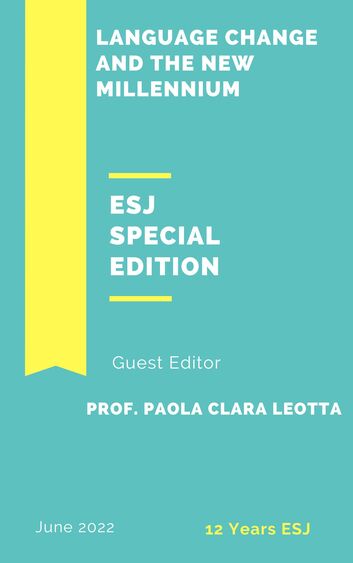The Use of Literature in EFL Classroom: Italian Canadian Short Stories as a Teaching Innovation Experience Through Flipped Classroom Strategy
Abstract
The aim of this article consists of showing that motivation is necessary for the success of a teaching and learning experience in an online classroom. By using the flipped learning method, the student becomes the central part of learning, being more active than in the traditional class and taking responsibility for his/her learning. He/she goes from being a mere spectator who only listens to the teacher's speech to someone with a voice in the classroom structured to allow student to acquire knowledge and build different competencies. The experience described below by implementing the flipped learning in the subject Contemporary Culture and Society of the Anglophone Communities, of the online Bachelor's Degree in Spanish Language and Literature, at the University of Burgos, excitement and self-expression replaced fear and dread. This awareness helped students in the construction of critical thinking and, in this specific case, culture and literature represented a better way for students to understand and know the society in which the language used in the texts is the language spoken (Valdes, 1986). During the first phase of this experience, the 56 students were divided into 14 groups of four members in each one; they were given instructions by different videos recorded by the teacher and during which she explained what to do, how to develop the project and how to proceed and deliver the final task. She also introduced the general topic of the Unit “Acculturation, adaptation and sense of belonging in women emigrants through Italian Canadian short stories” by uploading different readings by different women writers who had migrated from Italy to Canada for different reasons and in different periods since XX century until today. Mostly based on real events, these writings unveil the different coping strategies deployed by Italian Canadian women and how they dealt with the complex process of settling into life in a new country. After having chosen the writer to work on the 14 groups proceeded to research and investigate them. They also kept regular contact with the teacher by fora or tutorials so the teacher could track and monitor their learning progress and needs. The project consisted of preparing a presentation on the woman writer selected including the context she lived in and her work. During the last phase, after the task delivery, she asked all groups to share the posters and presentations and to ask questions and comments about them in a forum opened for that purpose. Finally, a questionnaire on their perception of the flipped learning approach in the course was prepared and distributed to the students. The result of this experience has shown that the flipped learning strategy succeeded in motivating the students to build and acquire knowledge and to reach beneficial outcomes.
Downloads
Metrics
PlumX Statistics
References
2. Anakin, M. (2013). 30. Effective teaching strategies for a flipped classroom.
3. Albadalejo, M. D. (2007). Cómo llevar la literatura al aula de ELE: de la teoría a la práctica. Marco ELE. Revista de Didáctica Español Lengua Extranjera, (5), 1-51. retrieved from http://marcoele.com/descargas/5/albaladejo-literaturaalaula.pdf
4. Atta M. S. Salem, A. (2013). The Impact o Multiple Intelligences-Based Instruction on Developing Speaking Skills of the Pre-Service Teachers of English. English Language Teaching, 6(9).
5. Barrera, A. G. (2013). El aula inversa: cambiando la respuesta a las necesidades de los estudiantes. Avances en supervisión educativa, (19).
6. Bergmann, J., & Sams, A. (2012). Flip your classroom: Reach every student in every class every day. International society for technology in education.
7. Berenguer Albaladejo, C. (2016). Acerca de la utilidad del aula invertida o flipped classroom. Departamento de Derecho civil, Universidad de Alicante. España. Retrieved from: https://web.ua.es/es/ice/jornadas-redes-2016/documentos/tema-2/805139.pdf
8. Berrett, D. (2012). How ‘flipping’the classroom can improve the traditional lecture. The chronicle of higher education, 12(19), 1-3.
9. Collie, J., & Slater, S. (1987). Literature in the language classroom: A resource book of ideas and activities. Cambridge university press. Retrieved from https://www.academia.edu/12529875/Literature_in_the_Language_Classroom_by_Joanne_Collie_and_Stephen_Slater
10. García-Barrera, A. (2013). El aula inversa: cambiando la respuesta a las necesidades de los estudiantes. Descripción de la publicaciónAvances en Supervisión Educativa, (19), 1-8. Retrieved from: https://procomun.educalab.es/gl/system/files/posts/4084afa0-5f4f-40eb-b61b-02f7df82bad8/ase19_mono02.pdf
11. García Gómez, A. (2016). Aprendizaje inverso y motivación en el aula universitaria.
12. Gómez, M. A. B. (2016). Experiencia de la clase inversa en didáctica de las lenguas extranjeras. Educatio Siglo XXI, 34 (1 Marzo), 173-196.
13. Hernáez Lerena, M. J. (2014). Short-Story World: The Nineteenth-Century American Masters. La Rioja: Universidad de la Rioja servicio de publicaciones: Retrieved from https://dialnet.unirioja.es/servlet/libro?codigo=267875
14. Lazar, G. (1993). Literature and language teaching: A guide for teachers and trainers. Cambridge University Press. Retrieved from https://books.google.es/books?hl=es&lr=&id=NXfGQOTpFdMC&oi=fnd&pg=PR9&dq=lazar+g+1993&ots=ba_Sa6py4G&sig=EeEC4c3jQTlm2WsODGtGUFaUByM#v=onepage&q=lazar%20g%201993&f=false
15. Maley, A. (2012). Literature in Language Teaching. In McKay, S. L., Hu, G., & Renandya, W. A. (2012). Principles and practices for teaching English as an international language (Vol. 711). L. Alsagoff (Ed.). New York: Routledge (pp. 305-323). Nueva York: Routledge. Retrieved from https://vulms.vu.edu.pk/Courses/ENG513/Downloads/[ESL%20and%20applied%20linguistics%20professional%20series]%20Lubna%20Alsagoff._%20et%20al%20-%20Principles%20and%20practices%20for%20teaching%20English%20as%20an%20international%20language%20(2012,%20Routledge).pdf#page=306
16. Pardede, P. (2011). Using short stories to teach language skills. JET (Journal of English Teaching), 1(1), 14-27. Retrieved from https://parlindunganpardede.wordpress.com/using-short-stories-to-teach-language-skills/
17. Rico Vercher, M., & Rico Pérez, C. (2004). El portfolio discente. Universidad de Alicante.
18. Salem, A. A. M. (2013). The impact of technology (BBM and WhatsApp applications) on English linguistics in Kuwait. International Journal of Applied Linguistics and English Literature, 2(4), 65-69.
19. Steen-Utheim, A. T., & Foldnes, N. (2018). A qualitative investigation of student engagement in a flipped classroom. Teaching in Higher Education, 23(3), 307-324.
20. Tedesco, J. C. (2010). La educación en el horizonte 2020: documento básico, Educación y justicia, el sentido de la educación. Fundación Santillana.
21. Valdes, J. M. (1986). Culture in literature. Culture bound, 137-147.
Copyright (c) 2022 Concetta Maria Sigona

This work is licensed under a Creative Commons Attribution-NonCommercial-NoDerivatives 4.0 International License.








